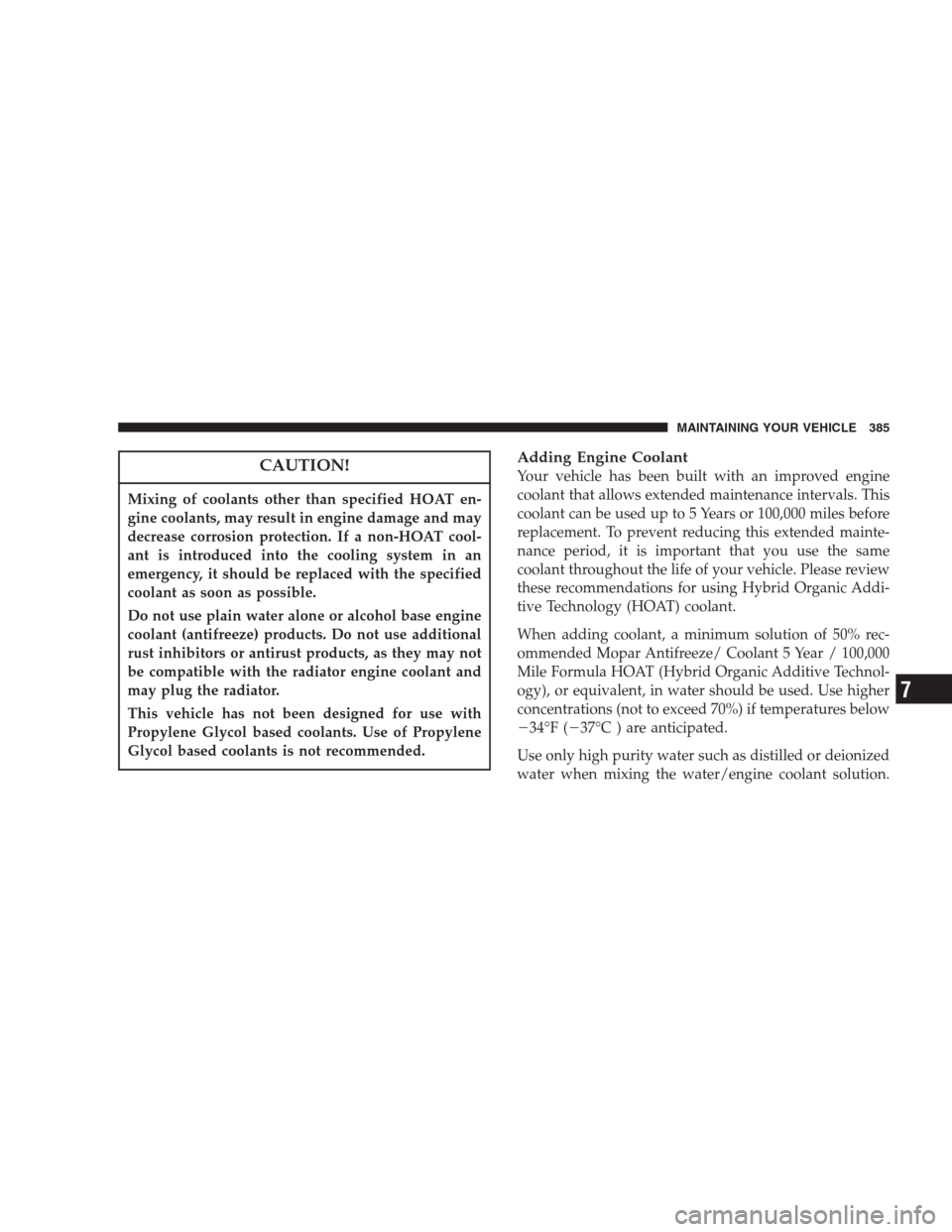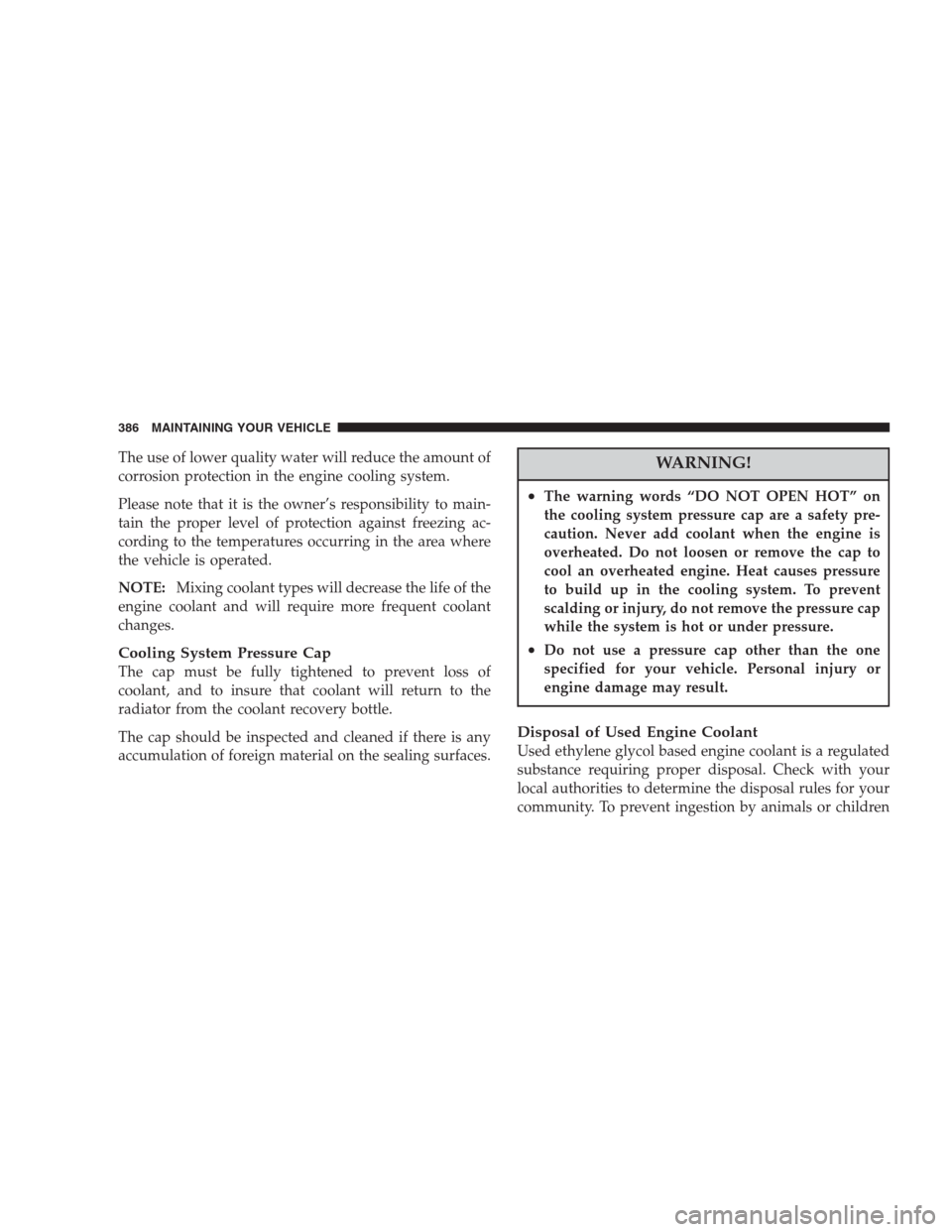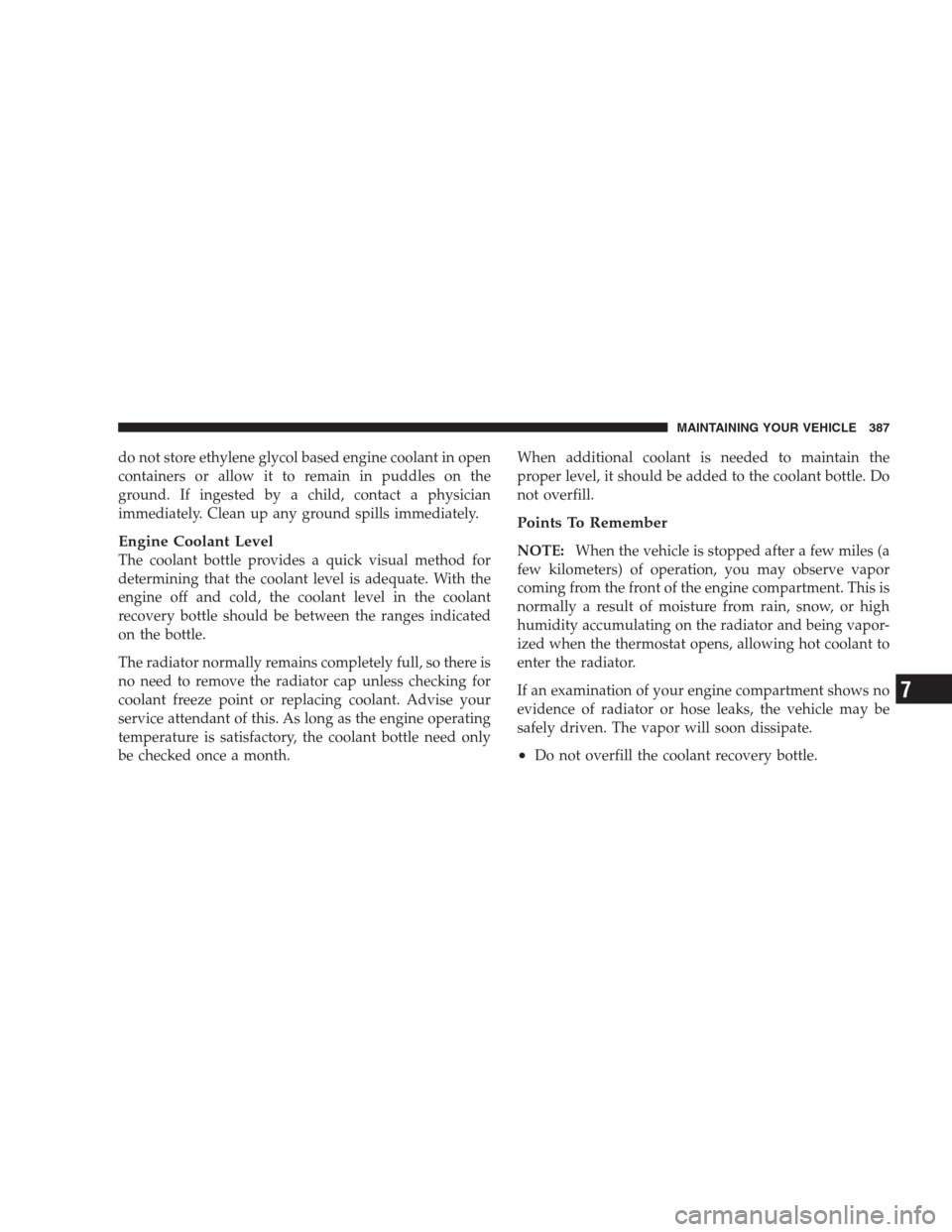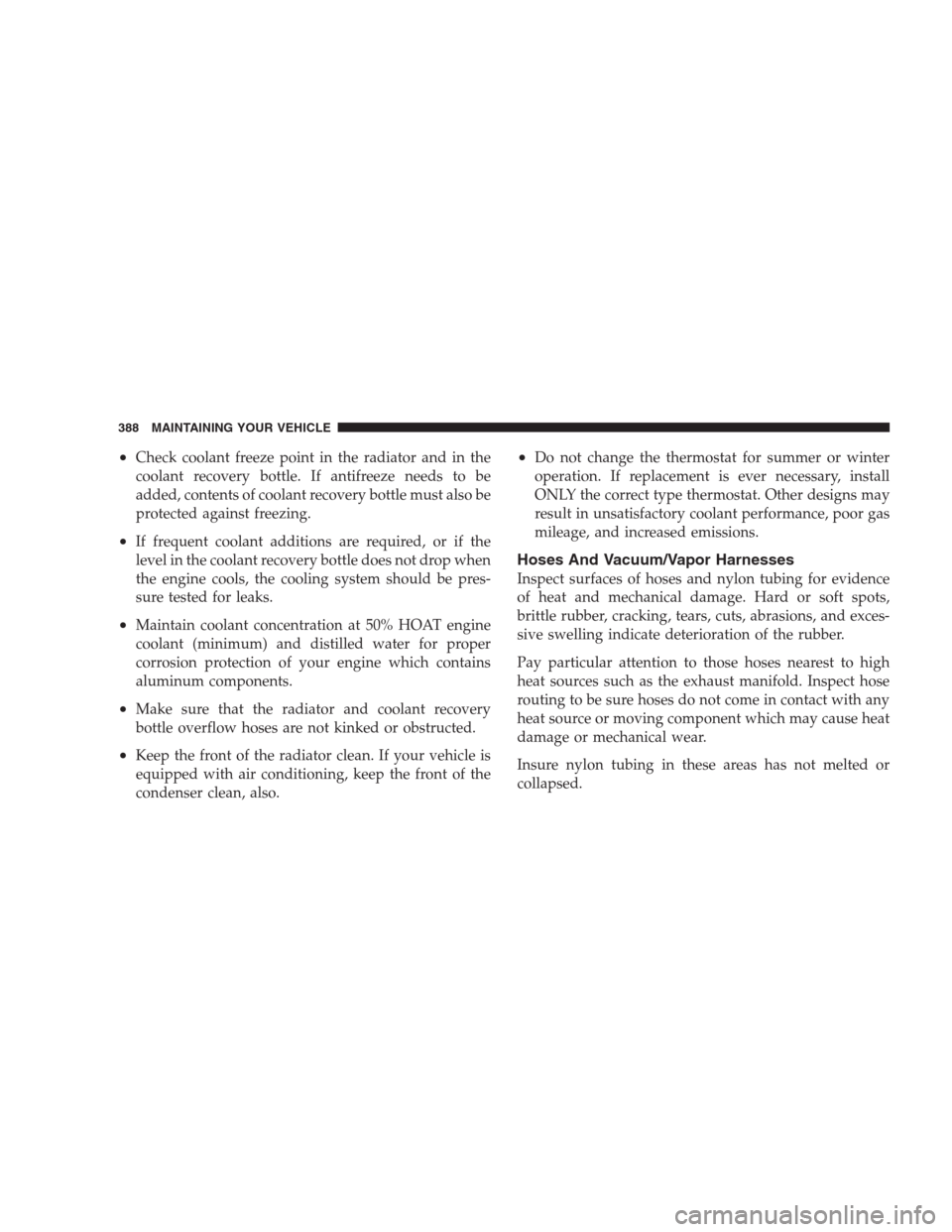Page 385 of 464

CAUTION!
Mixing of coolants other than specified HOAT en-
gine coolants, may result in engine damage and may
decrease corrosion protection. If a non-HOAT cool-
ant is introduced into the cooling system in an
emergency, it should be replaced with the specified
coolant as soon as possible.
Do not use plain water alone or alcohol base engine
coolant (antifreeze) products. Do not use additional
rust inhibitors or antirust products, as they may not
be compatible with the radiator engine coolant and
may plug the radiator.
This vehicle has not been designed for use with
Propylene Glycol based coolants. Use of Propylene
Glycol based coolants is not recommended.
Adding Engine Coolant
Your vehicle has been built with an improved engine
coolant that allows extended maintenance intervals. This
coolant can be used up to 5 Years or 100,000 miles before
replacement. To prevent reducing this extended mainte-
nance period, it is important that you use the same
coolant throughout the life of your vehicle. Please review
these recommendations for using Hybrid Organic Addi-
tive Technology (HOAT) coolant.
When adding coolant, a minimum solution of 50% rec-
ommended Mopar Antifreeze/ Coolant 5 Year / 100,000
Mile Formula HOAT (Hybrid Organic Additive Technol-
ogy), or equivalent, in water should be used. Use higher
concentrations (not to exceed 70%) if temperatures below
�34°F (�37°C ) are anticipated.
Use only high purity water such as distilled or deionized
water when mixing the water/engine coolant solution.
MAINTAINING YOUR VEHICLE 385
7
Page 386 of 464

The use of lower quality water will reduce the amount of
corrosion protection in the engine cooling system.
Please note that it is the owner’s responsibility to main-
tain the proper level of protection against freezing ac-
cording to the temperatures occurring in the area where
the vehicle is operated.
NOTE:Mixing coolant types will decrease the life of the
engine coolant and will require more frequent coolant
changes.
Cooling System Pressure Cap
The cap must be fully tightened to prevent loss of
coolant, and to insure that coolant will return to the
radiator from the coolant recovery bottle.
The cap should be inspected and cleaned if there is any
accumulation of foreign material on the sealing surfaces.
WARNING!
•The warning words “DO NOT OPEN HOT” on
the cooling system pressure cap are a safety pre-
caution. Never add coolant when the engine is
overheated. Do not loosen or remove the cap to
cool an overheated engine. Heat causes pressure
to build up in the cooling system. To prevent
scalding or injury, do not remove the pressure cap
while the system is hot or under pressure.
•Do not use a pressure cap other than the one
specified for your vehicle. Personal injury or
engine damage may result.
Disposal of Used Engine Coolant
Used ethylene glycol based engine coolant is a regulated
substance requiring proper disposal. Check with your
local authorities to determine the disposal rules for your
community. To prevent ingestion by animals or children
386 MAINTAINING YOUR VEHICLE
Page 387 of 464

do not store ethylene glycol based engine coolant in open
containers or allow it to remain in puddles on the
ground. If ingested by a child, contact a physician
immediately. Clean up any ground spills immediately.
Engine Coolant Level
The coolant bottle provides a quick visual method for
determining that the coolant level is adequate. With the
engine off and cold, the coolant level in the coolant
recovery bottle should be between the ranges indicated
on the bottle.
The radiator normally remains completely full, so there is
no need to remove the radiator cap unless checking for
coolant freeze point or replacing coolant. Advise your
service attendant of this. As long as the engine operating
temperature is satisfactory, the coolant bottle need only
be checked once a month.When additional coolant is needed to maintain the
proper level, it should be added to the coolant bottle. Do
not overfill.
Points To Remember
NOTE:When the vehicle is stopped after a few miles (a
few kilometers) of operation, you may observe vapor
coming from the front of the engine compartment. This is
normally a result of moisture from rain, snow, or high
humidity accumulating on the radiator and being vapor-
ized when the thermostat opens, allowing hot coolant to
enter the radiator.
If an examination of your engine compartment shows no
evidence of radiator or hose leaks, the vehicle may be
safely driven. The vapor will soon dissipate.
•Do not overfill the coolant recovery bottle.
MAINTAINING YOUR VEHICLE 387
7
Page 388 of 464

•Check coolant freeze point in the radiator and in the
coolant recovery bottle. If antifreeze needs to be
added, contents of coolant recovery bottle must also be
protected against freezing.
•If frequent coolant additions are required, or if the
level in the coolant recovery bottle does not drop when
the engine cools, the cooling system should be pres-
sure tested for leaks.
•Maintain coolant concentration at 50% HOAT engine
coolant (minimum) and distilled water for proper
corrosion protection of your engine which contains
aluminum components.
•Make sure that the radiator and coolant recovery
bottle overflow hoses are not kinked or obstructed.
•Keep the front of the radiator clean. If your vehicle is
equipped with air conditioning, keep the front of the
condenser clean, also.
•Do not change the thermostat for summer or winter
operation. If replacement is ever necessary, install
ONLY the correct type thermostat. Other designs may
result in unsatisfactory coolant performance, poor gas
mileage, and increased emissions.
Hoses And Vacuum/Vapor Harnesses
Inspect surfaces of hoses and nylon tubing for evidence
of heat and mechanical damage. Hard or soft spots,
brittle rubber, cracking, tears, cuts, abrasions, and exces-
sive swelling indicate deterioration of the rubber.
Pay particular attention to those hoses nearest to high
heat sources such as the exhaust manifold. Inspect hose
routing to be sure hoses do not come in contact with any
heat source or moving component which may cause heat
damage or mechanical wear.
Insure nylon tubing in these areas has not melted or
collapsed.
388 MAINTAINING YOUR VEHICLE
Page 411 of 464
FLUIDS AND CAPACITIES
U.S. Metric
Fuel23 gallons 87 liters
Engine Oil-With Filter
4.0 Liter Engines (SAE 10W-30, API Certified) 5.5 qts 5.2 liters
3.8 Liter Engines (SAE 5W-20, API Certified) 5.0 qts 4.7 liters
Cooling System *
4.0 Liter Engines (Mopar�Antifreeze/Coolant 5 Year/
100,000 Mile Formula or equivalent)10.7 qts 10.1 liters
3.8 Liter Engines (Mopar�Antifreeze/Coolant 5 Year/
100,000 Mile Formula or equivalent)11.8 qts 11.2 liters
* Includes heater and coolant recovery bottle filled to MAX level.
MAINTAINING YOUR VEHICLE 411
7
Page 412 of 464
FLUIDS, LUBRICANTS AND GENUINE PARTS
Engine
Component Fluids, Lubricants and Genuine Parts
Engine Coolant Mopar�Antifreeze/Coolant 5 Year/100,000 Mile Formula HOAT (Hybrid Or-
ganic Additive Technology) or equivalent
4.0 Liter Engine Oil Use API Certified SAE 10W-30 engine oil, refer to oil viscosity chart for cor-
rect SAE grade meeting DaimlerChrysler Material Standard MS-6395.
3.8 Liter Engine Oil Use API Certified SAE 5W-20 engine oil. Refer to your oil filler cap for cor-
rect SAE grade, meeting DaimlerChrysler Material Standard MS-6395.
Spark Plugs Refer to the Vehicle Emission Control Information label in the engine com-
partment.
Oil Filter, 4.0/3.8 Liter Engines Mopar�5281090 or equiv.
Fuel Selection 89 Octane
412 MAINTAINING YOUR VEHICLE
Page 418 of 464
Once a Month
•Check tire pressure and look for unusual wear or
damage.
•Inspect the battery and clean and tighten the terminals
as required.
•Check the fluid levels of coolant bottle, brake master
cylinder and transmission, add as needed.
•Check all lights and all other electrical items for correct
operation.At Each Oil Change
•Change the engine oil filter.
•Inspect the exhaust system.
•Inspect the brake hoses.
•Inspect the CV joints and front suspension compo-
nents.
•Check the automatic transmission fluid level.
•Check the coolant level, hoses, and clamps.
418 MAINTENANCE SCHEDULES
8
M
A
I
N
T
E
N
A
N
C
E
S
C
H
E
D
U
L
E
S
Page 425 of 464
Miles 93, 000 96, 000 99, 000 100, 000 102, 000 105, 000
(Kilometers) (149 000) (154 000) (158 000) (160 000) (163 000) (168 000)
Change engine oil and engine oil filter.XXX XX
Rotate TiresXX
Inspect the brake linings.X
Inspect the engine air cleaner filter, replace if necessary. *XXX X
Replace theengine air cleaner filter
*X
Replace engine timing belt.X
Change the All Wheel Drive (AWD) power transfer unit
fluid. (See note at the end of this chart)X
Change the All Wheel Drive (AWD) rear carrier fluid.
(See note at the end of this chart)X
Inspect the serpentine drive belt, replace if necessary. ‡X
Flush and replace the engine coolant.X
Replace the air conditioning filter.X
Engine Coolant — Flush and replace at 5 years of 100,000
miles whichever occurs first.X
SCHEDULE “B” 425
8
M
A
I
N
T
E
N
A
N
C
E
S
C
H
E
D
U
L
E
S